Making Soap – Part 1
A couple years ago, I became interested in making homemade soap. So I began to do some research. But I ran into a hitch – homemade soap contains lye, or sodium hydroxide. . Isn’t that dangerous stuff? Well, yes, it is. It’s very caustic, and can burn if it gets on your skin. But I continued to research and found that soap cannot be made without lye. Every bar of soap contains fats or oils, water and lye. When combined together and allowed to cure, these basic ingredients turn into soap. It is no longer oil or lye, but something else altogether: soap. Look at the ingredients on a bar of soap.
This one contains sodium tallowate (beef fat and lye) and sodium cocoate (coconut oil and lye). Soap manufactures don’t want to scare off their customers by putting the word lye on the packaging, but it’s in there, even your most delicate skin soaps. So don’t be scared of lye. You just have to give it respect in it’s raw form, and wear the proper gear when using it, ie, gloves, goggles, and long sleeves. So far Harland and I have made 6 batches of soap, never had any problems, and have used our own homemade soap for washing and bathing ever since.
So, here’s how we made a batch of soap last weekend.
Soap Ingredients
- 28 ounces of coconut oil
- 24 ounces of olive oil (lightest in color)
- 30 ounces of vegetable shortening
- 12 ounces of lye
- 32 ounces cold water (4 cups)
Yield: 7 pounds or 28 4 ounce bars soap
First, measure out the oils. The measurements have to be exact, so the oils are weighed. I do this using a postal scale. First I weigh the container I’ll use to hold the oils, in this case it was 5.5 oz, and then add that number to the ounces called for each oil. The recipe calls for 28 ounces of coconut oil, so I kept adding the oil to the container until the scale read 33.5 ounces.
I emptied the oil into a large pot, making sure to scrape all of it out.
Next I weighed and then added vegetable shortening to the pot,
and then did the same with the olive oil.
Then I put the pot on the stove, and melted it down into a liquid over medium heat.
When melted, remove pot from heat, insert a candy thermometer, and allow to cool to about 105 degrees F.
While it is cooling, measure out the lye into a clean container. But before we open the lye container, now is the time that children and pets should leave the room.
Kitty is not happy about this, but we have her best interest at heart. She was sent upstairs and the door closed behind her.
When handling lye, I always wear a long sleeve shirt, gloves, and goggles. To measure out the lye, I use a plastic cup. Weigh it empty first, and then add that weight to the number of ounces of lye called for in the recipe.
Then measure out the water. As the recipe calls for cups, I just use a measuring cup and don’t weigh the water.
Note that the container says 100% lye. While most drain cleaners contain lye, they also have other ingredients. For soapmaking, it has to be 100 % lye, with nothing else added. I get ours at our local farm and home store.
Now it’s time to add the lye to the water. I usually do this outdoors or in a well ventilated area. Because it was dark outside and for the sake of taking pics, we stayed inside and used the chore sink in the mud room. The water has been poured into a plastic pitcher. Using a plastic spoon, stir the water as you SLOWLY pour the lye into the water.
I threw the plastic cup away, and continued to stir until all the lye was dizzolved. Insert a candy thermometer into the water/lye solution, and allow to cool to 100 degrees F. To hasten the cooling of both the oil and the water/lye solution, we placed both containers outside where it was about 30 degrees F. Just make sure that no pets or children will have access to them.
We use the time waiting for everything to cool by lining the soap mold with freezer paper, which will allow easy removal of the soap from the mold.
Harland made this mold from the directions on this soapmaking website, Miller’s Homemade Soap pages. All the soap recipes on that site fit perfectly into this mold. We plugged in our stick blender, and had our stainless steel large mixing bowl ready along with a plastic spatula. We kept an eye on the oil and lye water, and when they reached the desired temperatures, we brought them in.
Pour the oil into the mixing bowl,
and then carefully stir in the lye water.
Insert the blender into the mixture, and turn on.
Blend while stirring for about 20 seconds, then turn off and continue to stir. Then turn it back on and stir for another 20 seconds. Continue to do this until the soap begins to trace. “Trace” is when the soap has been mixed enough. It will get a satin look to the surface, and if some of the soap is dripped onto the surface it stays there leaving a trace, hence the term. This batch of soap took about 15 minutes to trace. Sometimes it takes even less time.
When our soap traced, we poured it into the mold.
Then we inverted a cardboard box over the top and covered it with a couple large towels to keep it warm.
Leave it this way undisturbed for 24 hours. During this time the soap will increase in temperature as it begins to cure, and then slowly cool back down again. After 24 hours, the soap will be ready for cutting.
NOTE: If you are interested in making soap, please don’t use this post as your sole information. I did a lot of reasearch, and so should you. There’s a lot to learn about soapmaking before you make your first batch. Miller’s Homemade Soap is a great place to learn everything you need to know about making soap. Kathy Miller has been making soap for over 30 years, and so she knows her stuff. I did a lot of reading, I then looked for videos about soapmaking online and found quite a few of them out there.
~~~~~~~~~~~~~~~~~~~~
——–> UP NEXT: Come back for the rest of the the soapmaking, part 2. We unmold the soap and cut it into bars.
—–> And Later This Week: A winter sunrise.

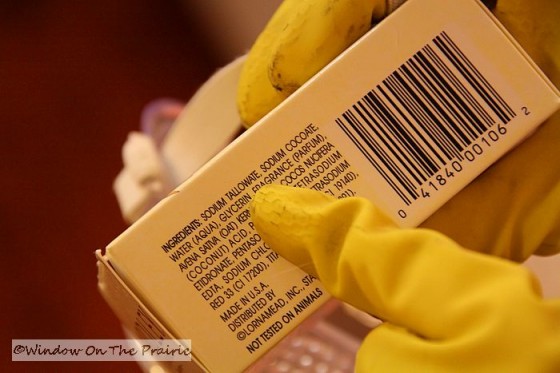
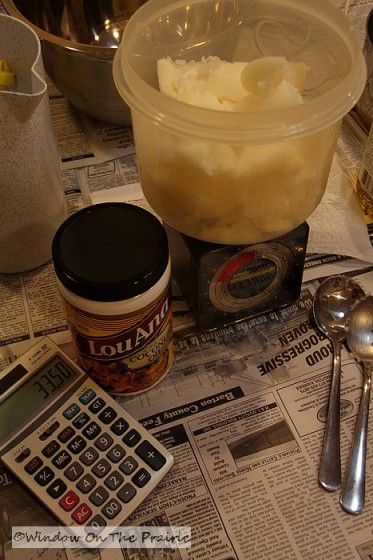
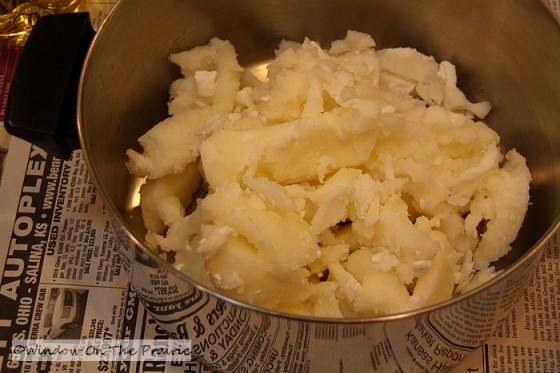
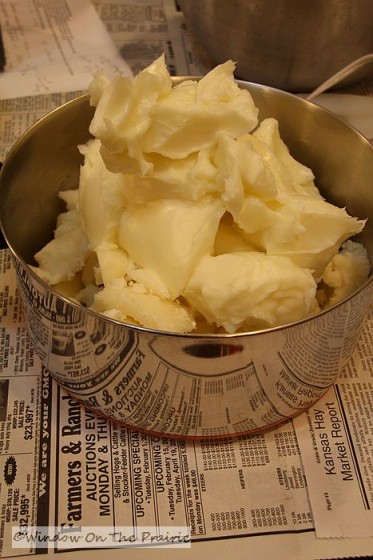
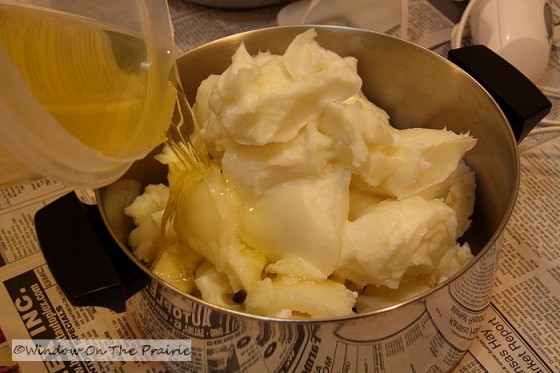
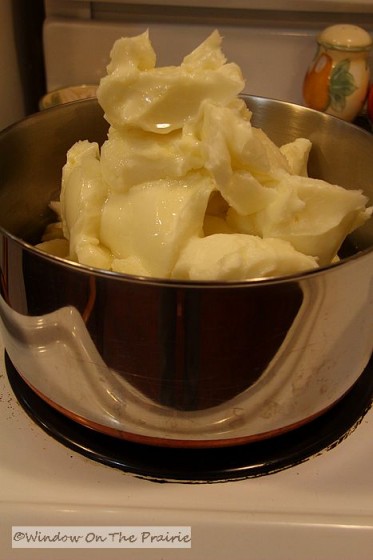
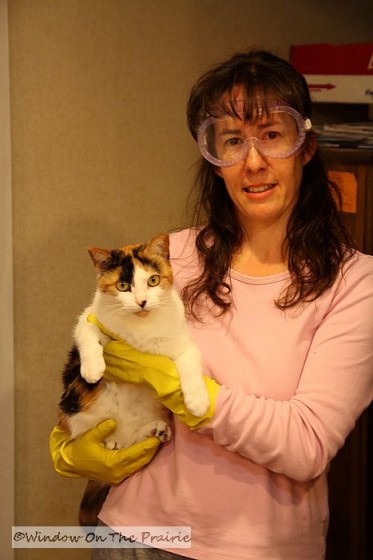
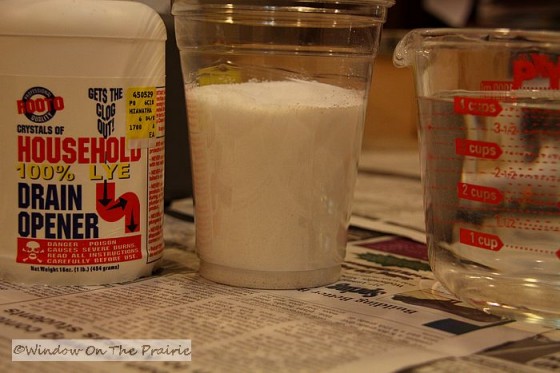
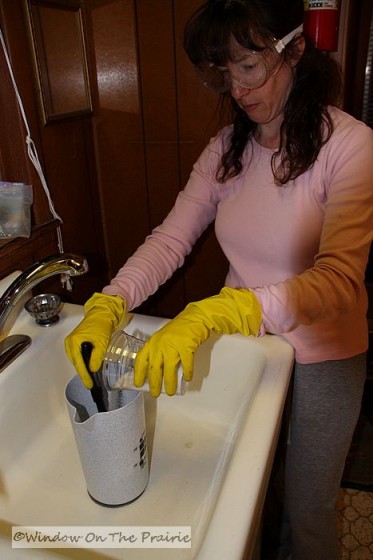
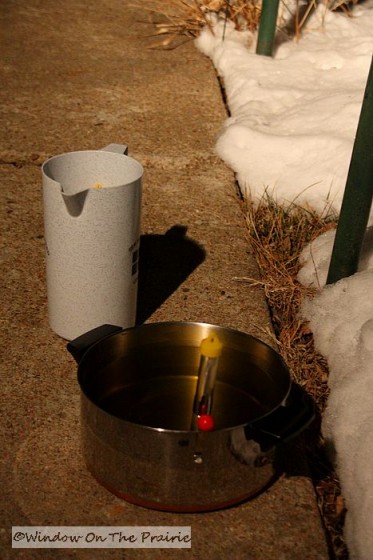
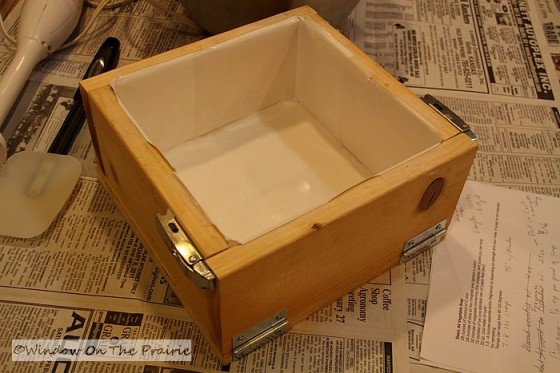
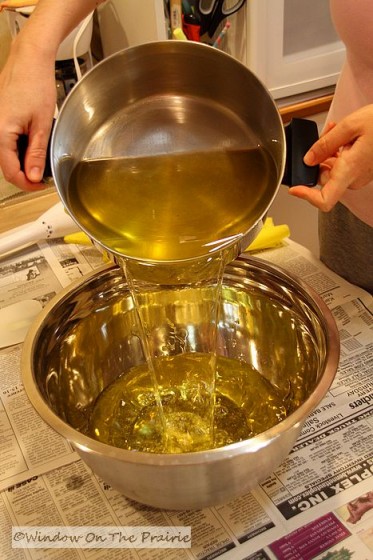
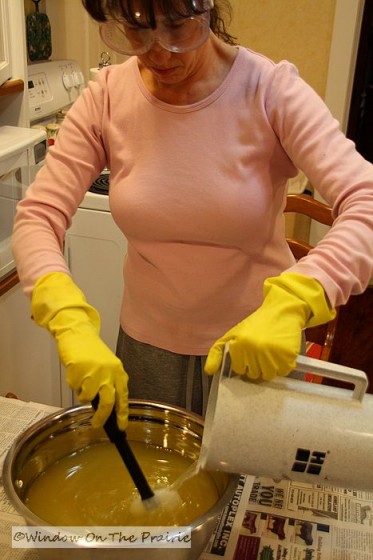
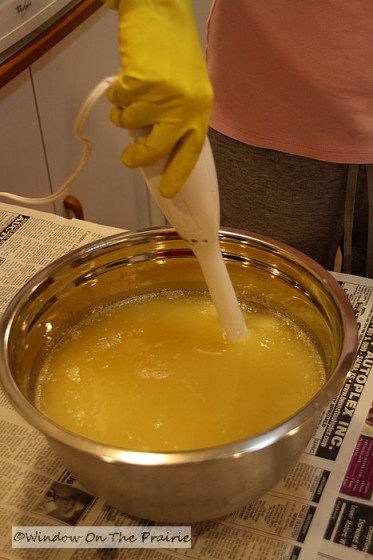
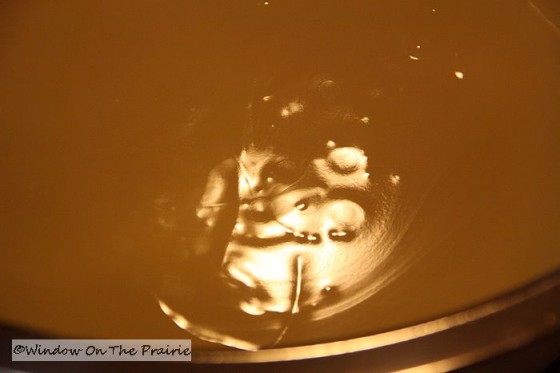
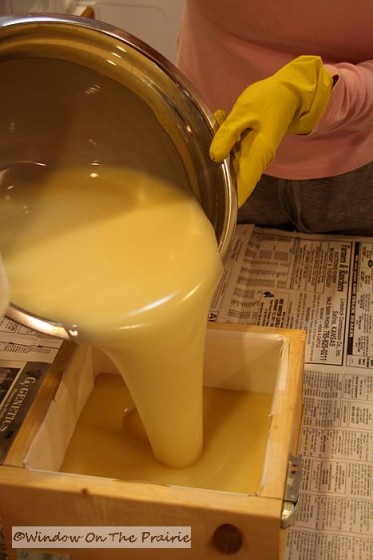
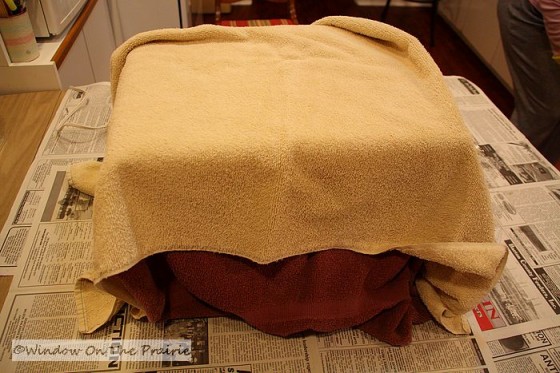
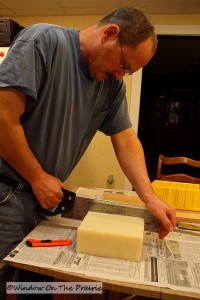

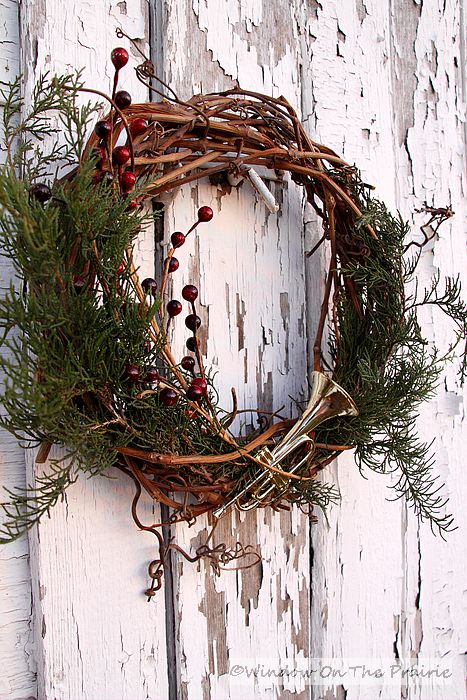
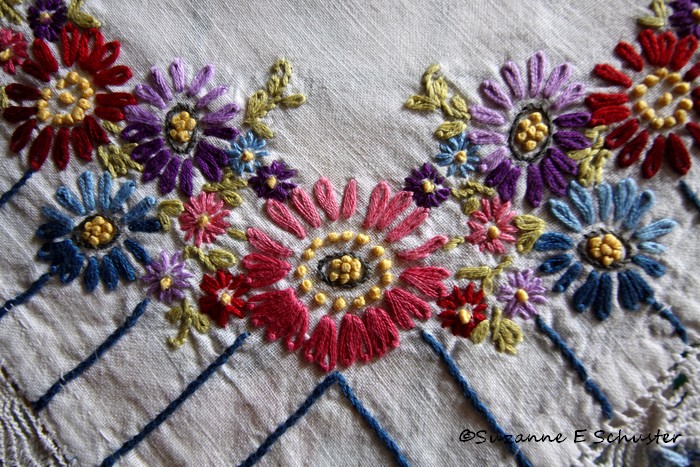
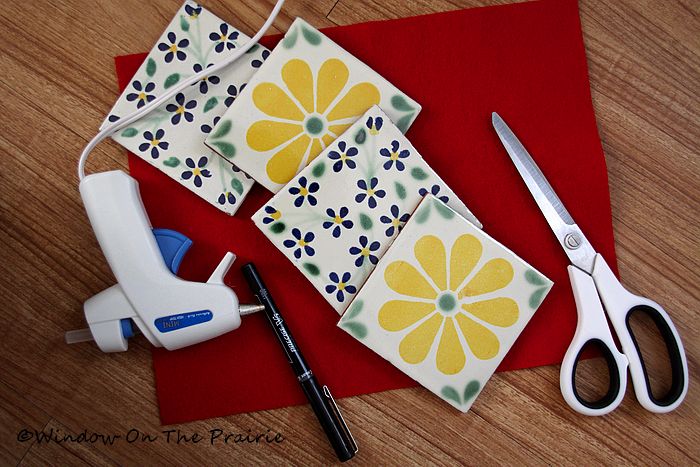
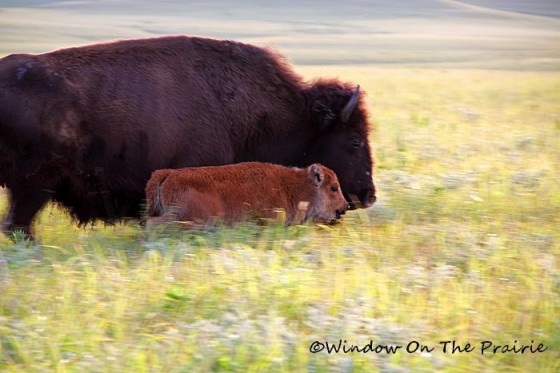
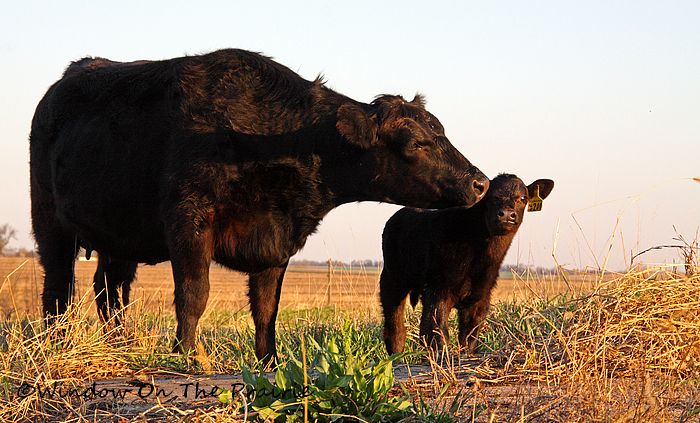

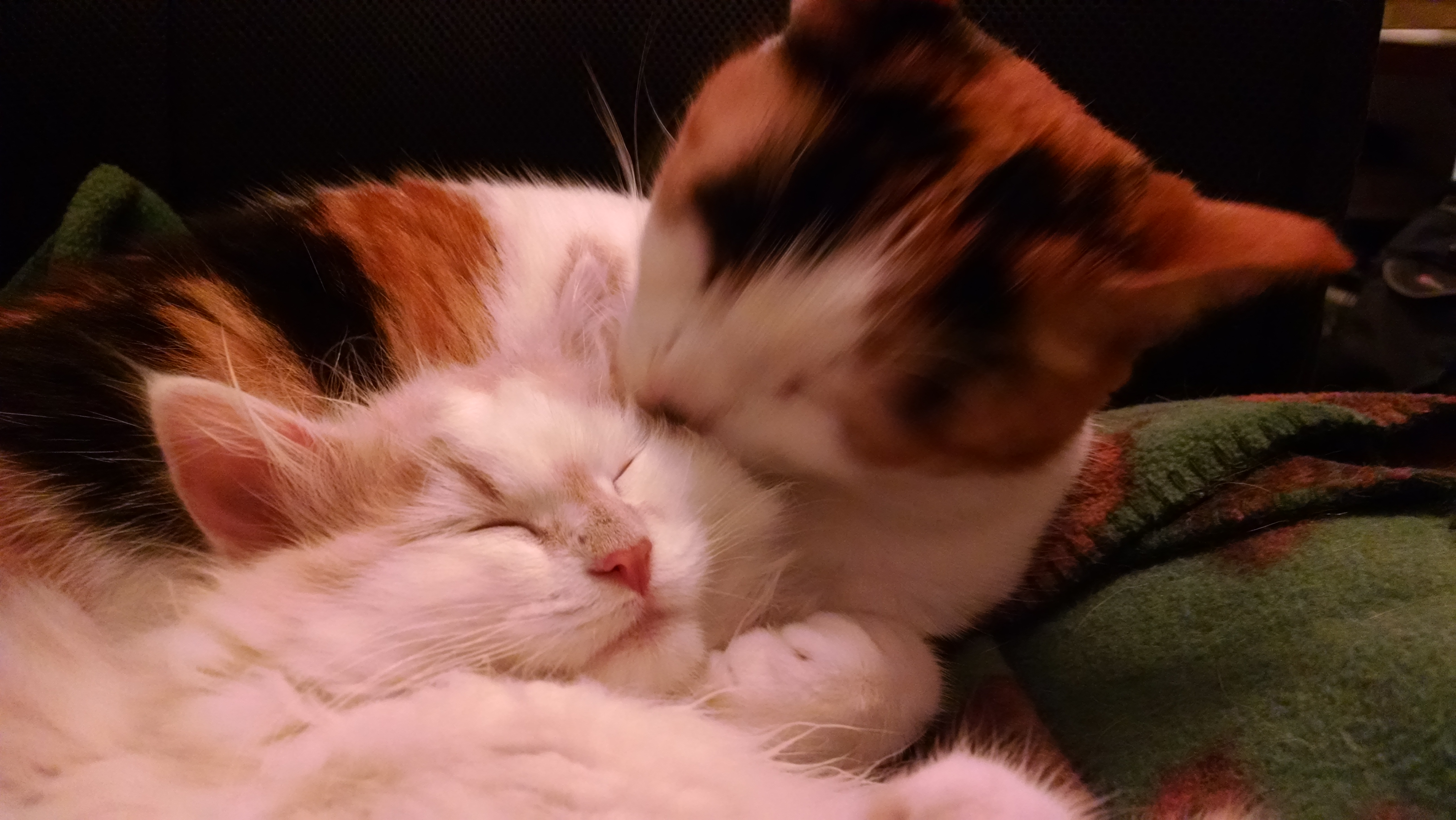
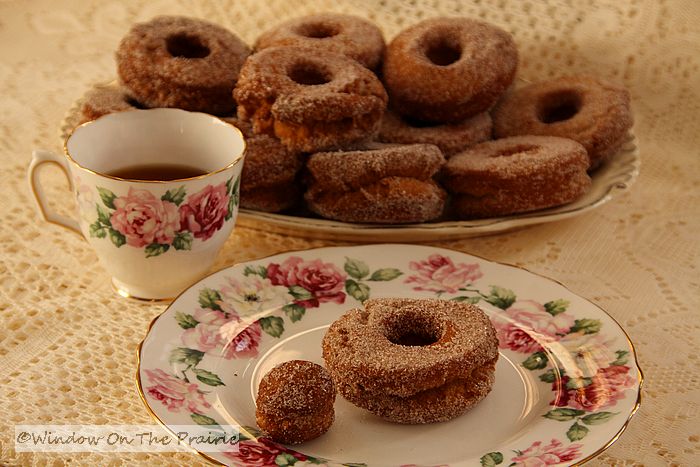
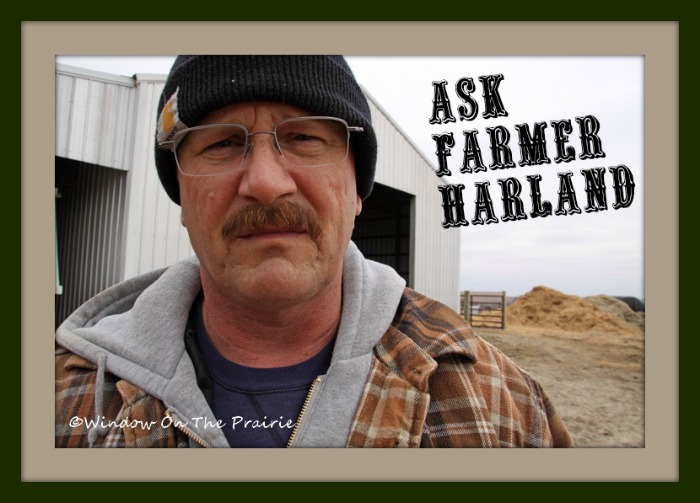
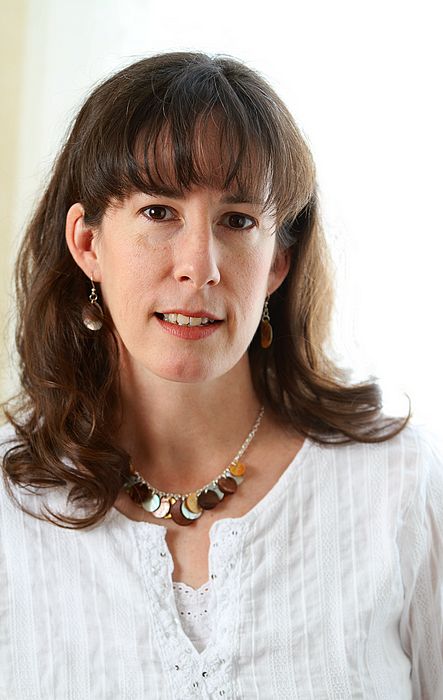


Looks great! I am planning a soap making tutorial later in the week. I haven’t done any soaps yet that are with goat milk. Yours looks great!
I have made soap but have not done so in a long time. I used lard. When you said “vegetable shortening” did you mean Crisco?
Hi Glyndalyn,
Yep. I used a generic brand though.
Oh goodness! I won’t go into the details, but the last time I was around soapmaking, it was outside in a washpot!! And it was fabulous soap.
You don’t add any fragerance or essential oils? Does your soap smell better without it? I haven’t tried making soap yet. I’ve decided that is one thing I’ll just buy 🙂
Hi Shelljo,
I’ve made batches before with scents and dyes. But this time we just wanted plain old soap. And it has a clean scent of its own too.
I enjoyed the video of the storm, it is howling here as well.
Nice to see how you make the wonderful soap that I love. It really is nice even without the fragrance.
Hi Glenda,
Next time you come out for a visit, you’ll have to take more soap home with you. It will be cured by then.
Yes, yes yes! I am loving this! I have never done this before, but I have always wanted to. I am so jealous. The reason I have never done it is because I was always afraid of the lye! and that ain’t no lie! ha ha! Now that I have seen you do this, and I can see that you are alive and well, and have not been burned, I think I now have the courage to do this! Yay! You are awesome! Thank you for posting this!
I’ll have to try this some time, it looks fun. I make my own laundry soap. I made your chicken last night & we really enjoyed it. My 5 year old daughter saw your post pulled up on the computer & was so excited to see we were making the same thing as you. She loves to look at your pictures while I read aloud to her, especially the ones with Kitty.
Patty 🙂
Hi Patty,
So glad you enjoyed the chicken recipe. And let your daughter know that now that I know how to post videos, Kitty will make her video debut soon. She’s been practicing in front of a mirror. 🙂
Wow! I can’t believe you and Harland did all this! You are so luck that Harland loves you enough to help and be a part of what you do! You are so creative. I really wished I lived next door to ya. Everytime you do something, I want to try too. You did great job describing every step of the way. Thanks so much for sharing this!
You’re quite welcome Peggy,
I wish I could have everyone in my kitchen when I cook or make soap.
Loved this entry.
SUZANNE!!!! Guess what??!?!? WE DID IT! We made SOAP!!!! Oh holy cow, it’s SOAP! WE MADE SOAP, and I can bathe with it and it WORKS! We’ve crossed our fingers for six weeks waiting for it to cure, and I used a bar last night for the first time!!! Thank you for giving us the courage to try this! You are wonderful!
Kit,
Great!!! So glad this worked for you. When I made soap for the first time, (and every time since) I was so excited. Isn’t it fun and so satisfying to “do it yourself” ? And you know exactly what your soap is made of. Great news.!
I recently bought some lavender essential oil and will be making another batch of soap soon with lavender scent. Can’t wait.
Your calico reminds me of ours. I can see yours has as much personality as ours…and my husband carries ours around the same way. 🙂
when adding essential oils, how much per pound
Not sure….I just find a recipe from a reputable source and follow it to the letter.
Thanks! After having to take a trip to our local church’s food pantry they gave us a bar of soap that some well-meaning person had made for donation. I decided after having to use the awful bar that I had to make something better for those unable to buy. I am going to research how much these items will cost, but plan on doing this soon. My hubby finally got a job and I look forward to giving back.
I’ve been making homemade soap for about 10 yrs. I started also by reading Miller Homemade soaps web site. I have used her recipes, only tweaking them a bit to make it my own. I eventually got into making my soap using ALL NATURAL INGREDIENTS! Right down to collecting Rain water, & natural
minerals/spices for colorants. I also used several different oils… Olive, palm, palm kerrnel, soy bean, cocoa butter, coconut, grapeseed, vegetable shortening. Tried canola oil, but found that in hotter climates like where I live the canola oil will weep from the soap bar. I also got into fragrances using essential oils & fragrant oils. After a few yrs I started making my soap using the hot process way, but still using cold process recipes. Found that by using hot process my soap was ready to use the next day. I to was making 8 lb batches each time, and my husband made me wooden molds with latches & a lid. I hope you enjoy your journey in homemade soap making.
hey, I am wanting to make with fresh goats milk, would I use the same ounces of frozen goats milk as the water you have posted?
I would recommend you find a recipe specifically for goats’s milk soap. Milk generates a lot of heat during the soapmaking process and recipes have to be tailored to account for the extra heat. Good Luck!
we are waiting on our first batch to cool down so we can mix the lye and oil together. We are excited.
our first batch was a bust after 4hrs it never traced. We through it out. We are going to try it again soon.
This is the very best soapmaking tutorial I have seen yet. Thank you!😃😊😀
I have had better luck with using powered goats milk when making soap. You don’t have to worry about the heat causing it to curdle. I just add about 1/4 cup (per 5lb bar) at trace when you add all the rest of your essentials oils etc. Once the soap is ready to use it is just a creamy and smooth as if you had used raw goats milk.
I noticed that you didn’t add a scent to this. Why?
Hye..how long should we cure this soap?
Hi, im from Croatia, so i don t know what is vegetable shortening?
Can you explain or write another word for that please. 😊
Plain old Margarine (or margarin), but, be careful, not the “spreadable” crap in plastic tubs (a.k.a. Linco – contains a bit of fat and tons of water), just the ancient stuff our moms used to make cakes (such as Rama blocks)
Please help me. I did mine but it came out watery. Please help me I love to make home made plans
A friend of mine stopped by yesterday and gave me a piece of her homemade soap. It makes me thinking of learning how to make soap as well, so now here I am doing my research and encounter your site and hoping to learn from your tutorial here. Thank you for your assistance. Menchie
I really want to make soap and have been looking all over the web for help.
I live in Liberia and here, we only have palm oil and palm kernel oil. Coconut oil is also available but expensive – I wont mind the cost of the coconut oil for what its worth.
can you please help me with a formula using 100% single oil as well as a combination of the 3 oils.
Thanks a lot in advance.
John
I used this last night to make soap for the first time and it was a total success! Thank you so much for making this easy and fun for me! I have a friend who is wanting to follow your recipe but wants to replace the crisco with a different kind of fat. Any idea what kinds would be an option and how much to use?
What a wonderful, informative post! I am so glad I found this site on Pinterest! I have been researching into making my own homemade soap for my family and I really appreciate you sharing your wisdom. This is one of, if not THE, best posts I have seen for basic soapmaking. Soon I will be ready to try & I know I will have this post pulled up on my tablet, right beside me! Thank you!
Health & Wealth to You & Yours